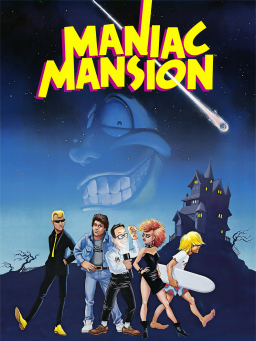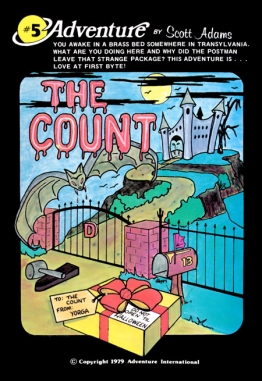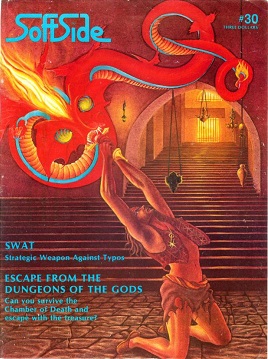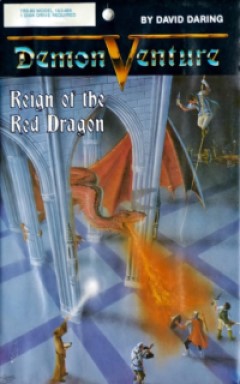
Maniac Mansion is a 1987 graphic adventure video game developed and published by Lucasfilm Games. It follows teenage protagonist Dave Miller as he attempts to rescue his girlfriend Sandy Pantz from a mad scientist, whose mind has been enslaved by a sentient meteor. The player uses a point-and-click interface to guide Dave and two of his six playable friends through the scientist's mansion while solving puzzles and avoiding dangers. Gameplay is non-linear, and the game must be completed in different ways based on the player's choice of characters. Initially released for the Commodore 64 and Apple II, Maniac Mansion was Lucasfilm Games' first self-published product.

Zork is a text adventure game first released in 1977 by developers Tim Anderson, Marc Blank, Bruce Daniels, and Dave Lebling for the PDP-10 mainframe computer. The original developers and others, as the company Infocom, expanded and split the game into three titles—Zork I: The Great Underground Empire, Zork II: The Wizard of Frobozz, and Zork III: The Dungeon Master—which were released commercially for a range of personal computers beginning in 1980. In Zork, the player explores the abandoned Great Underground Empire in search of treasure. The player moves between the game's hundreds of locations and interacts with objects by typing commands in natural language that the game interprets. The program acts as a narrator, describing the player's location and the results of the player's commands. It has been described as the most famous piece of interactive fiction.

Computer Gaming World (CGW) was an American computer game magazine published between 1981 and 2006. One of the few magazines of the era to survive the video game crash of 1983, it was sold to Ziff Davis in 1993. It expanded greatly through the 1990s and became one of the largest dedicated video game magazines, reaching around 500 pages by 1997.

Deadline is an interactive fiction detective video game published by Infocom in 1982. Written by Marc Blank, it was Infocom's third game. It was released for the Amstrad CPC, Apple II, Atari 8-bit computers, Commodore 64, IBM PC, Osborne 1, TRS-80, and later for the Amiga and Atari ST.

Mystery House is an adventure game released by On-Line Systems in 1980. It was designed, written and illustrated by Roberta Williams, and programmed by Ken Williams for the Apple II. Mystery House is the first graphical adventure game and the first game produced by On-Line Systems, the company which would evolve into Sierra On-Line. It is one of the earliest horror video games.

Labyrinth: The Computer Game is a graphic adventure game developed by Lucasfilm Games and published in 1986 by Activision. Based on the fantasy film Labyrinth, it tasks the player with navigating a maze while solving puzzles and evading dangers. The player's goal is to find and defeat the main antagonist, Jareth, within 13 real-time hours. Unlike other adventure games of the period, Labyrinth does not feature a command-line interface. Instead, the player uses two scrolling "word wheel" menus on the screen to construct basic sentences.

Raiders of the Lost Ark is an action-adventure game for the Atari 2600 released in 1982, based on the 1981 film of the same name. The game was designed by Howard Scott Warshaw.

Pirate Adventure is a text adventure video game written by Scott Adams. It was published by Adam's company, Adventure International, in 1979.
Sherlock Holmes: Consulting Detective is a game originally published by Sleuth Publications in 1981. Multiple expansions and reprints of the game have since been released.

The Count is a text adventure written by Scott Adams and published by Adventure International in 1979. The player character has been sent to defeat the vampire Count Dracula by the local Transylvanian villagers, and must obtain and use items from around the vampire's castle in order to defeat him.

SoftSide is a defunct computer magazine, begun in October 1978 by Roger Robitaille and published by SoftSide Publications of Milford, New Hampshire.
An adventure game is a video game genre in which the player assumes the role of a protagonist in an interactive story, driven by exploration and/or puzzle-solving. The genre's focus on story allows it to draw heavily from other narrative-based media, such as literature and film, encompassing a wide variety of genres. Most adventure games are designed for a single player, since the emphasis on story and character makes multiplayer design difficult. Colossal Cave Adventure is identified by Rick Adams as the first such adventure game, first released in 1976, while other notable adventure game series include Zork, King's Quest, Monkey Island, Syberia, and Myst.

Empire of the Over-Mind is an interactive fiction game written by Gary Bedrosian and published by Avalon Hill for the Apple II, Atari 8-bit computers, and TRS-80 in 1981. A version with an enhanced display for IBM PC compatibles by Bedrosian was published in 1986.

Robot Attack is a clone of the arcade game Berzerk written by Bill Hogue and Jeff Konyu for the TRS-80 and published by Big Five Software in 1981. It was the first game from Big Five to include speech.

The Eliminator is a horizontally scrolling shooter written by Terry Gilman and Wayne Westmoreland for the TRS-80 and published by Adventure International in 1981. It was ported to the Atari 8-bit computers and Apple II. The Eliminator is a clone of the Defender arcade game.

Galaxy is a 1981 video game published by Avalon Hill and developed by Microcomputer Games for the Apple II, TRS-80, Atari 8-bit computers, Commodore PET, Commodore 64, IBM PC compatibles, FM-7, and TI-99/4A. It was originally published as Galactic Empires by Powersoft in 1979.

Starfighter is a video game published by Aardvark Technical Services in 1979 for Ohio Scientific computers. Three versions of the game were sold so they could work on a range of OSI hardware: Starfighter 540, Starfighter 600, and Starfighter Alphabetics. It was ported to the TRS-80 and TRS-80 Color Computer.

Klondike Adventure is a video game published in 1982 by SoftSide for the Atari 8-bit computers. It was the February 1982 Adventure of the Month, and the ninth in the series.

Crystal Caverns is a text adventure written for the Apple II by Daniel Kitchen of Imaginative Systems Software. It was published by Hayden Software in 1982, followed by a Commodore 64 port in 1984.

Reign of the Red Dragon is video game written by David Daring for the TRS-80 and published by Adventure International in 1982.


















